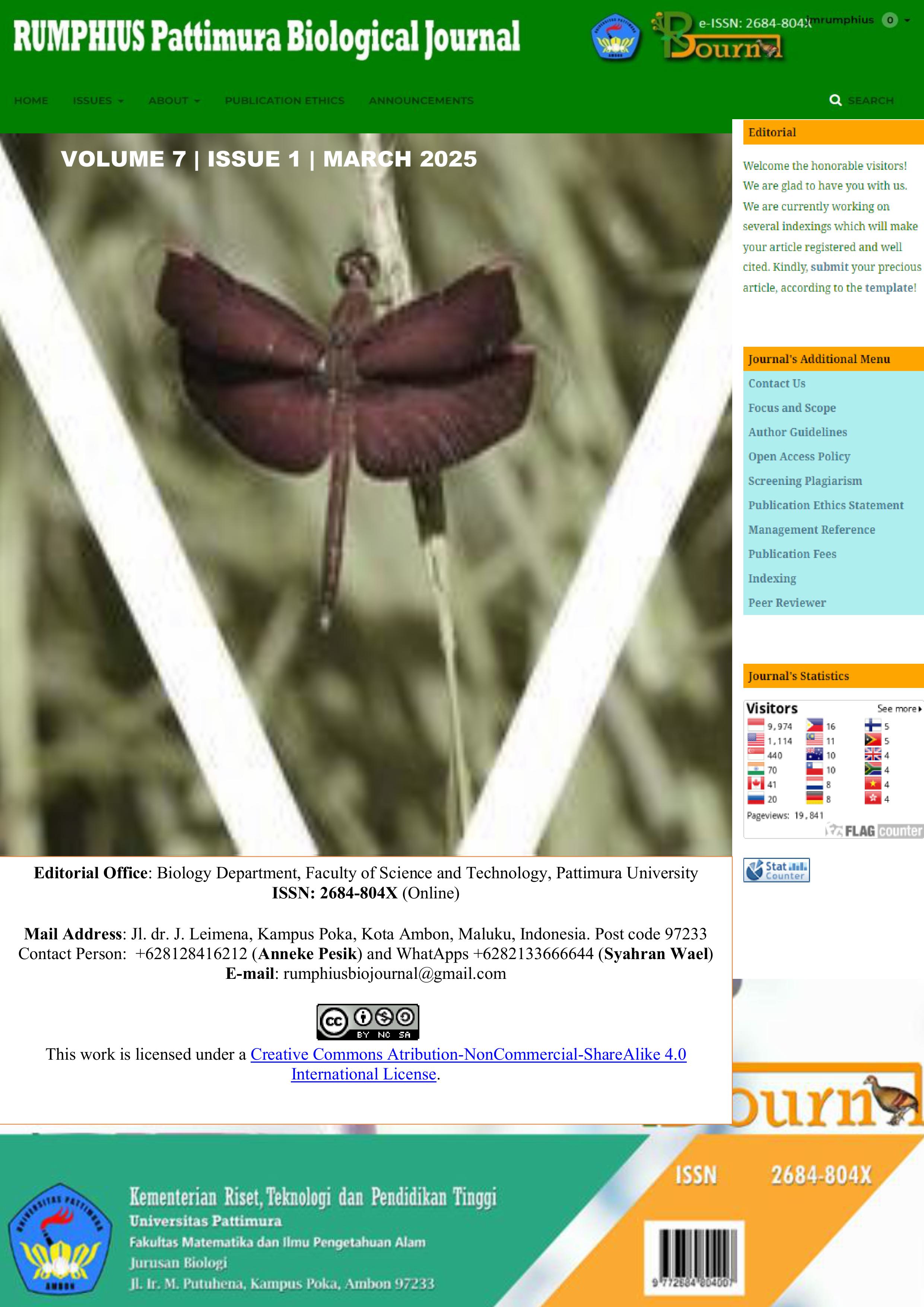Pollen Morphology of the Four Species Asteraceae
Abstract
Asteraceae has many species and pollen shape varies. Pollen becomes one of the characteristics of the species and data on the morphological characteristics of pollen can help taxonomic data. This study aimed to determine the morphological character of pollen from four species of the Asteraceae. Pollen from Tridax procumbens, Tagetes erecta, Zinnia angustifolia, and Z. elegans was taken from the flower and smeared on a glass object and then dripped with distilled water. Fresh preparations were observed with a fluorescens microscope. The pollen shapes of the four species had monad prolate spheroidal (T. erecta, Z. elegans), monad subsphreoidal (Tr. procumbens), and monad oblate-spheroidal (Z. Angustifolia). Zinnia angustifolia had microechinate pollen ornamentation while another species had echinate pollen ornamentation. The four species had aperture varies, i.e tricolpate (T. erecta, Z. elegans), tetracolporate (Tr. procumberns), and monocolpate (Z. Angustifolia). Tagetes erecta had the biggest diameter pollen (51,405 µm) than the pollen diameter of another species (30,618-36,043 µm). Pollen morphology could differentiate of the four species Asteraceae members.
Downloads
References
Abas, M., & Sucianto, E. T. (2020). Feed resources determination based on pollen diversity in Trigona bees (Trigona sp.) colony. Biosciences: Journal of Biology & Biology Education, 12(3), 478-487
Broholm, S. K., T.H. Teeri & P. Elomaa. (2014). Molecular Control of Inflorescence Development in Asteraceae. Advances in Botanical Research. 72, 297–333
Bohm, B. A. and T. F. Stuessy. (2001). Flavonoids of The Sunflower Family (Asteraceae). Springer Science & Business Media. New York. pp. 4-7.
Boyle, T. H. (1996). Backcross Hybrids of Zinnia angustifolia and Z. violacea: Embryology, Morphology, and Fertility. J. Amer. Soc. Hort. Sci. 121(1), 27–32
Das, S.K., and Mukherjee, S.K. (2013). Comparative Morphological, Anatomical and Palynological Observations in Ageratum conyzoides and Ageratum houstonianum of the Family Compositae. Research Articles, 2(4), 48-62
Erdtman, G. (1952). Pollen Morphology and Plant Taxonomy of Angiosperms (An Introduction to Palynology I). The Chronica Botanica Co. Waltham, Mass. USA.
Jeffrey, C. (1982). An Introduction to Plant Taxonomy Second Edition. Cambridge University Press. Great Britain.
Patma, D. P., Abas, G. M., Khoerinnisa, N. N., Muzakki, N. A., Adawiyah, W. R., & Rahmi, K., N. A. (2018). Observation of Asteraceae pollen structure. FPMIPA, Indonesian Education University Bandung. pp. 1-4
Perveen, A. (1999). Contributions to the Pollen Morphology of the Family Compositae. Tr. Journal of Biology, 23, 523-535
Pertiwi, R.H., Hendra, M., Syafrizal. (2015). Palynological Study of Asteraceae Family in Botanical Garden of Mulawarman University Samarinda (Krus). Proceedings of Final Project Seminar FMIPA Mulawarman University, 1(1), 1-7
Gusmalawati, D., Huda, M.F., Fauziah, S.M., Banyo, Y.E., Abidin, Z. (2021). Morphological Characterization of Pollen from Ten Types of Plants from Different Families. Journal of Applied Technology, 4(2), 303-308
Rashid M. (2013). Identification of Three Medicinally Important Species of the Family Asteraceae Based on Pollen Characters. Annals of Plant Sciences. 02(01), 40-45
Copyright (c) 2025 Dewa Nure Kabela, Dina Novita Anggraini, Keisya Khoerunnisa, Wulan Putri Dina Lestari, Priyanti Priyanti

This work is licensed under a Creative Commons Attribution-NonCommercial-ShareAlike 4.0 International License.
Authors who propose a manuscript and have it approved for publication know that the manuscript will be registered and become part of the RPBJ. Authors and readers understand that this journal is open and all its contents can be accessed freely, provided that RPBJ is still listed as the source of information. The hope is that this journal can become a vehicle for exchange and scientific knowledge for society and the scientific community, especially in the field of Biology and other branches of science.









